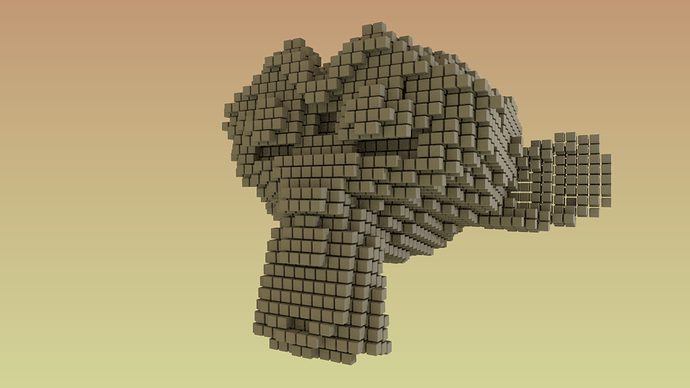I really like the special effects in the Black Eyed Peas The Time (Dirty Bit) music video. http://www.youtube.com/watch?v=JwQZQygg3Lk How might I go about making something like this? I don’t necessarily want it to follow head movement, but having it just turn from a picture of a head into a cube would be cool, maybe then having the camera rotate around it while it pixelizes. Surely it wasn;t animated frame by frame, that would have taken forever!
A higher-resolution image, or – better yet – a link to a movie file would certainly help us understand what you’re trying to accomplish here…
Aah! Sorry about that! I must not have actually presses the “C” when i tried to copy the link! The original post was edited and now has a link to the video. And thanks liero, but after I set it to grid, none of the physics values seem to change anything.
EDIT: Never mind, object visualization fixed it! Thanks! Now is there any way that I could animate the resolution of the grid to decrease in increments while the size of the cube grows, ending in the box shape in the video?
Please, any way to animate the resolution size?
Hi, you could have different objects and switch between them, or maybe just one object and different particle systems, where you play with start-end and lifetime… A very simple example of switching settings here.
But if all you want is a cube you don’t even need particles… the hard stuff anyway is the texturing and compositing. Good luck and have fun…!
I tried adding multiple particle systems, but I couldn’t figure out how to animate them to change and the second one overlaps the first. I tried to change the start and end times and set the lifetime to 19, but it still overlapped and nothing visibly changed. Also, how would I animate the cube size along with the changing particles?
Hi, I attached a file last time so you could check it. That is one way and there may be other options, for instance working with pixelated textures…
Here goes a new one. What I did was create many particle systems as you see in the picture. The trick is they do not overlap in time, and as the grid resolution is bigger the size of the particle gets smaller. You need some simple math here, you increase one and decrease the other…
But again, this was a concept, and the video is not really 3D all the time as I remember, it looked a bit faked in my opinion…
Keep it up!
Attachments
ARO.blend (551 KB)
Yea, some of the time they’re doing something along the lines of what liero is showing, and some of the time they’re using a 2D filter – something like the “Mosaic” filter in After Effects.
Actually, I’m thinking voxels could be an interesting approach to this, but I’m not sure I’m smart enough to actually come up with an example…
Even if I have the first particle system set to (res:80 start:1 end:1 and life 19) and the second particle system to (res:60 start:21 end:21 and life 19), both particle systems are visible at frame 1.
Hi, just bumping to let you know I wrote a script that could be useful in your project -if you are still on it- http://blenderartists.org/forum/showthread.php?t=207861 
I like that Atom, dupliverts are cool! The pixelate script makes use of them too.
But all the hard work was done in C4D  You could use Blender to render a zbuffer or map a gradient as they did to get a displacement map. I would also like to try some similar stuff with MiikaH’s Mesh Paint.
You could use Blender to render a zbuffer or map a gradient as they did to get a displacement map. I would also like to try some similar stuff with MiikaH’s Mesh Paint.
@Atom watched your tutorial yesterday and liked it. You tried the zbuffer option but projecting a ramp is also a good one, you can use a material with a blend texture and set it to override others.
The other stuff I think you may try is posterizing the output so you get closer to a pixelization effect, not just a Pin Screen one. Check the file and toggle the ramp between Constant and Linear to see a way of doing this.
Attachments
sideramp.blend (251 KB)


